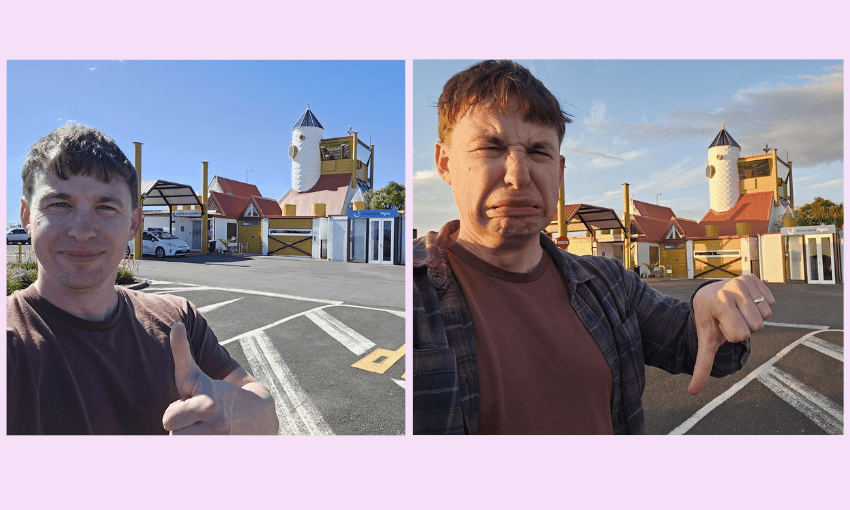What was meant to be a day assessing the country’s most architecturally significant airport turned into a cautionary tale about the decline of regional air travel.
Whakatāne airport looks magnificent at sunset. Its random array of pitched roofs glow in the dimming light. The signature tower leading up to its air traffic control office points like a spear towards the clear sky, the three circular windows below its turret roof aligned to resemble a golden Pingu saying “noot noot”. The vista is breathtaking and I wish to God I had never seen it, because if you’re at Whakatāne airport at sunset on a Friday, you might never get out of town.
Left: Whakatāne airport’s tower at sunset. Pingu saying ‘noot noot’ (Photo: Hayden Donnell)
Things had started out so well. Sure, my Air Chathams flight from Auckland was delayed by an hour and 45 minutes, but the airline made up for it with plenty of legroom, a two-seat row to myself, and a Tim Tam doled out by the lone flight attendant somewhere over the rolling paddocks of Waikato. I was heading down to interview Whakatāne’s new mayor and assess the airport in person for an as-yet unspecified top secret Spinoff project.
A week before my trip, Air New Zealand’s new chief executive had gone on the radio calling for a “situational” subsidy for regional air travel. He argued some of the current routes weren’t financially sustainable and would need help to keep going through tough economic times. I listened to it live. Sounds troubling, I thought. Luckily it wouldn’t have any effect on my life.
Idiot. (Image: Hayden Donnell)
If I was experiencing even an inkling of worry, it evaporated soon after landing. The Roger Walker-designed airport is a striking, tone-setting introduction to the sun-soaked coastal community. “Welcome to Whakatāne” reads the sign above its runway-side entrance, which is roughly 15 steps away from the sliding doors that lead out into its front carpark.
Happier times. (Selfie: Hayden Donnell)
The expanding pool of tranquility in my mind only became more placid. Whakatāne is pretty great, particularly if you’re being ferried between its most interesting locations by friendly council staff. Lunch was at Tio Ōhiwa. The Ōhope oyster farm runs a takeaway joint out of a slightly ramshackle wooden kiosk on the side of the Pacific Coast Highway. It was bought out recently by a family connected to local iwi Ngāti Awa, who have expanded and upgraded its oyster beds.
Laden with oysters, pāua fritters and kokoda, I slumped into the front seat of Ngāti Awa senior leader Mike Panapa’s car for a tour of the district’s most significant sites. First, Te Hau Tutua Park, where the iwi’s first waka came ashore, and then on to the nearby marae, Mataatua. Ngāti Awa calls the marae the house that came home. It was returned to the whenua in 2011 after spending more than 100 years in Australia and England. Finally we arrived at Kāpū-te-rangi, the hilltop pā site that was once home to the iwi’s tupuna Toi, where you can look out over Whakatāne and into the distance, where the maunga Pūtauaki (Mt Edgecumbe) stands alone.
Mataatua. (Photo: Hayden Donnell)
On the way back to the airport, I stopped at Julians Berry Farm for an ice cream. It was the last sliver of joy I’d experience for some time. At 3.15pm, an email came through announcing my 4.55pm flight out of Whakatāne had been cancelled for unspecified “operational reasons”. As he drove out of the carpark, the airport’s runway manager checked I had the wifi password and leaned out the window to helpfully inform me that Air Chathams often just doesn’t have enough staff to run its Friday flights.
The cancellation email promised a replacement bus service, departing at the same time as the flight’s scheduled takeoff. “They jumped the gun on that one,” said the woman at the airport’s front desk, looking at once concerned and quite fucked off. She’d been engaged in a fruitless effort to find a bus rental company willing to travel to Auckland at late notice on a Friday.
A nice email to get from your HR manager.
There were no buses, no planes, and Air Chathams doesn’t run flights out of Whakatāne on Saturday. Some passengers bought flights out of Tauranga and took off due north in a hurry with harried looks on their faces. But I didn’t have a car, and the only rental vehicles available at the airport were commercial trucks. The Spinoff’s HR manager Gemma rang to talk over the situation. Her voice had a slightly manic edge. “I shouldn’t laugh,” she said. “But it’s just so bad.”
It was another hour or so before I got any confirmation that I might be able to get home at any point in my life. They’d found a shuttle bus, but there was a catch: it was leaving around 9pm earliest. I checked the ETA for home. 2am, said Google Maps, snarkily. I called my wife on Messenger to see my children in their Halloween costumes, then went outside to take photos of the airport as golden hour wound down. It would be another two hours before the shuttle finally arrived. By the time we left the sun was long gone, and the only thing I could see was darkness.
Absolutely stunning. (Photo: Hayden Donnell)

